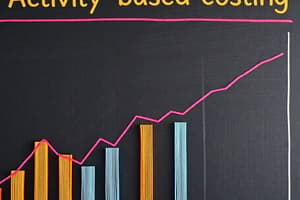Podcast
Questions and Answers
Which of the following is a characteristic of the traditional approach to overhead allocation?
Which of the following is a characteristic of the traditional approach to overhead allocation?
- Indirect costs are ignored entirely
- Overheads are allocated based on actual usage
- Costs are distributed based on production volumes (correct)
- Direct costs are more difficult to allocate
What is the primary focus of Activity Based Costing?
What is the primary focus of Activity Based Costing?
- Maximizing production volume
- Allocation of direct costs
- Absorbing all costs equally
- Charging indirect costs to products (correct)
What is a key step in the traditional approach to apportionment of indirect costs?
What is a key step in the traditional approach to apportionment of indirect costs?
- Allocation of service department overheads (correct)
- Elimination of overhead costs
- Direct allocation of costs to end products
- Reapportionment of direct costs
In Activity Based Costing, indirect costs are allocated based on what principle?
In Activity Based Costing, indirect costs are allocated based on what principle?
What does Life Cycle Costing focus on?
What does Life Cycle Costing focus on?
What is the goal of Target Costing?
What is the goal of Target Costing?
How does Activity Based Costing improve accuracy in cost allocation?
How does Activity Based Costing improve accuracy in cost allocation?
Which method divides costs based on departmental functions rather than product volume?
Which method divides costs based on departmental functions rather than product volume?
What is the predetermined overhead rate based on direct labor hours for the company?
What is the predetermined overhead rate based on direct labor hours for the company?
How much overhead is assigned to product A using activity-based costing?
How much overhead is assigned to product A using activity-based costing?
Which product has the highest activity cost assigned using the traditional method?
Which product has the highest activity cost assigned using the traditional method?
How is the activity cost driver rate for machine setup calculated?
How is the activity cost driver rate for machine setup calculated?
What is the total number of direct labor hours across all products A, B, and C?
What is the total number of direct labor hours across all products A, B, and C?
What is the total overhead allocated to product C using activity-based costing?
What is the total overhead allocated to product C using activity-based costing?
Which statement correctly describes the relationship between direct labor hours and overhead allocation in the traditional method?
Which statement correctly describes the relationship between direct labor hours and overhead allocation in the traditional method?
What is one major disadvantage of using activity-based costing compared to traditional overhead allocation?
What is one major disadvantage of using activity-based costing compared to traditional overhead allocation?
What is an example of a cost driver in activity-based costing (ABC)?
What is an example of a cost driver in activity-based costing (ABC)?
What calculation is used to determine the activity cost driver rate in ABC?
What calculation is used to determine the activity cost driver rate in ABC?
In activity-based costing, how are costs charged to products?
In activity-based costing, how are costs charged to products?
Which of the following is the first step in the activity-based costing process?
Which of the following is the first step in the activity-based costing process?
What does the activity cost driver indicate?
What does the activity cost driver indicate?
What is the total annual overhead cost provided for the company?
What is the total annual overhead cost provided for the company?
In the context of procurement expenses, what activity is used for cost allocation?
In the context of procurement expenses, what activity is used for cost allocation?
Which activity cost is allocated the highest annual expense?
Which activity cost is allocated the highest annual expense?
What is one of the last steps in the activity-based costing process?
What is one of the last steps in the activity-based costing process?
What is the main advantage of using Activity Based Costing (ABC)?
What is the main advantage of using Activity Based Costing (ABC)?
How many machine hours were recorded for product A?
How many machine hours were recorded for product A?
Which of the following best describes the purpose of creating a cost pool in ABC?
Which of the following best describes the purpose of creating a cost pool in ABC?
What is a drawback of the traditional method of overhead costing?
What is a drawback of the traditional method of overhead costing?
How many units of product B were produced annually?
How many units of product B were produced annually?
In terms of setups, how many were recorded for product B?
In terms of setups, how many were recorded for product B?
Which of the following does NOT represent an advantage of ABC?
Which of the following does NOT represent an advantage of ABC?
What is the formula for calculating target cost?
What is the formula for calculating target cost?
If a product is intended to be sold at $12 with a desired profit of $4, what is the target cost?
If a product is intended to be sold at $12 with a desired profit of $4, what is the target cost?
What is a potential advantage of using standard components in production?
What is a potential advantage of using standard components in production?
Which of the following actions can be implemented to meet target costs?
Which of the following actions can be implemented to meet target costs?
What is meant by the target cost gap?
What is meant by the target cost gap?
In the context of target costing, what is the importance of monitoring cost reductions?
In the context of target costing, what is the importance of monitoring cost reductions?
Which of the following could lead to increased costs in other areas when reducing costs in one area?
Which of the following could lead to increased costs in other areas when reducing costs in one area?
How should a company continuously apply target costing throughout a product's life?
How should a company continuously apply target costing throughout a product's life?
Flashcards are hidden until you start studying
Study Notes
Activity Based Costing
- Traditional approach allocates overhead based on direct labor hours or production volume.
- Activity based costing (ABC) allocates overhead based on activities that drive cost.
- Steps in ABC:
- Identify the activity.
- Create the cost pool.
- Determine the activity cost driver.
- Calculate the activity cost driver rate.
- Charge the costs of activities to products.
Advantages of ABC
- More accurate and reliable cost allocation
- Enables better pricing decisions
- Provides a realistic approach to overhead allocation.
- Controls costs by focusing on activities that drive overhead costs.
Target Costing
- Focuses on designing and producing products that meet a predetermined target cost.
- Target cost is the maximum allowable cost to produce, distribute, and dispose of a product
- Target cost = Target Selling Price – Target Profit
- Process:
- Calculate the target cost based on market price and profit margin.
- Evaluate actions to reduce costs and achieve the target.
- Monitor the cost reductions to ensure the actions are effective.
Target Cost Gap
- The difference between the estimated cost and the target cost.
- Methods to close the gap:
- Reduce the number of components.
- Use standard components.
- Train staff in more efficient techniques.
- Use different materials.
- Use cheaper labor.
- Acquire efficient technology.
- Eliminate non-value-added activities.
Studying That Suits You
Use AI to generate personalized quizzes and flashcards to suit your learning preferences.




